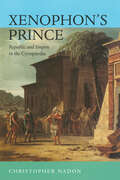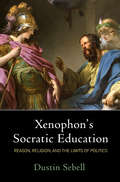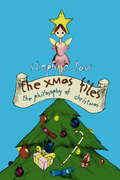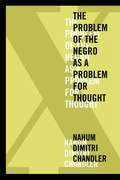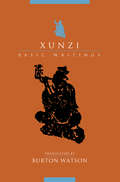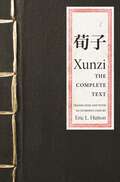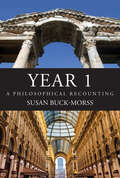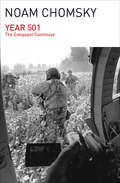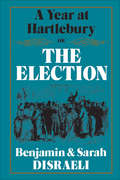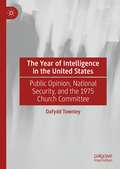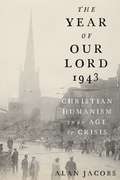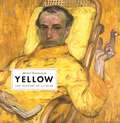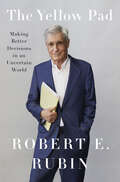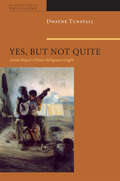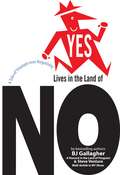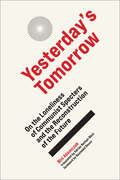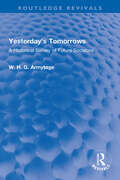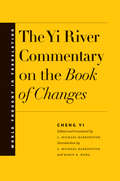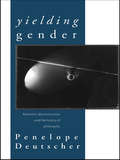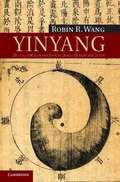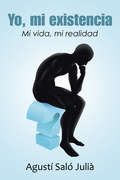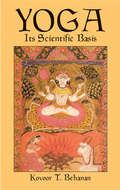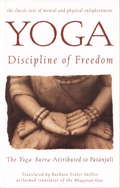- Table View
- List View
Xenophon's Prince: Republic and Empire in the Cyropaedia
by Christopher NadonFor over two millennia, the Cyropaedia, an imaginative biography of the Persian king Cyrus the Great, was Xenophon's most popular work and considered his masterpiece. This study contributes to the recent rediscovery of the Cyropaedia and Xenophon, making intelligible the high esteem in which writers of the stature of Machiavelli held Xenophon's works and the importance of his place among classical authors. The ending of the Cyropaedia has presented a notoriously difficult puzzle for scholars. The bulk of the work seems to idealize the career of Cyrus, but the final chapter documents the swift and disastrous degeneration of the empire he founded. This conclusion seems to call his achievements into question. Nadon resolves this long-standing interpretive difficulty and demonstrates for the first time the overall coherence and unity of the Cyropaedia. He elucidates the Xenophontic critique of Cyrus contained within the whole of the work and unearths its analysis of the limitations of both republican and imperial politics.This provocative and original treatment of the Cyropaedia will be a definitive step in restoring the status of this important work. Nadon's lively, insightful study draws upon his deep knowledge and understanding of classical political theory and reveals in the Cyropaedia a subtlety and sophistication overlooked until now.
Xenophon's Socratic Education: Reason, Religion, and the Limits of Politics
by Dustin SebellIt is well known that Socrates was executed by the city of Athens for not believing in the gods and for corrupting the youth. Despite this, it is not widely known what he really thought, or taught the youth to think, about philosophy, the gods, and political affairs. Of the few authors we rely on for firsthand knowledge of Socrates—Aristophanes, Xenophon, Plato, and Aristotle—only Xenophon, the least read of the four, lays out the whole Socratic education in systematic order.In Xenophon's Socratic Education, through a careful reading of Book IV of Xenophon's Memorabilia, Dustin Sebell shows how Socrates ascended, with his students in tow, from opinions about morality or politics and religion to knowledge of such things. Besides revealing what it was that Socrates really thought—about everything from self-knowledge to happiness, natural theology to natural law, and rhetoric to dialectic—Sebell demonstrates how Socrates taught promising youths, like Xenophon or Plato, only indirectly: by jokingly teaching unpromising youths in their presence. Sebell ultimately shows how Socrates, the founder of moral and political philosophy, sought and found an answer to the all-important question: should we take our bearings in life from human reason, or revealed religion?
The Xmas Files: The Philosophy Of Christmas
by Stephen LawA philosophical but fun look at the meanings of Christmas myths and rituals, from carving the turkey to why Santa wears red.Picture the scene: Aunt Gertrude has just given you the most appalling Christmas tie, complete with snow-flecked kittens in a bowler hat. Do you smile, nod, and confine it to the bottom drawer? Or do you tell the truth and spare yourself future ties from hell? Kant would say that we must, at all costs, tell the truth - whilst Mill would insist that we should think of the consequences. THE XMAS FILES is a philosophical meander though the myths and rituals of Christmas today, asking such important questions as does Santa exist? What's wrong with Christmas kitsch? Is it all just a commercial racket? What was Augustine's attitude to 'peace on earth'? And what would David Hume have to say about the virgin birth? For underneath all the festive fun, the way we celebrate Christmas does raise serious questions about the beliefs that sustain us, and the ways in which we still value ritual and tradition as a means of coming together.
The Xmas Files: The Philosophy of Christmas
by Stephen LawA philosophical but fun look at the meanings of Christmas myths and rituals, from carving the turkey to why Santa wears red.Picture the scene: Aunt Gertrude has just given you the most appalling Christmas tie, complete with snow-flecked kittens in a bowler hat. Do you smile, nod, and confine it to the bottom drawer? Or do you tell the truth and spare yourself future ties from hell? Kant would say that we must, at all costs, tell the truth - whilst Mill would insist that we should think of the consequences. THE XMAS FILES is a philosophical meander though the myths and rituals of Christmas today, asking such important questions as does Santa exist? What's wrong with Christmas kitsch? Is it all just a commercial racket? What was Augustine's attitude to 'peace on earth'? And what would David Hume have to say about the virgin birth? For underneath all the festive fun, the way we celebrate Christmas does raise serious questions about the beliefs that sustain us, and the ways in which we still value ritual and tradition as a means of coming together.
X—The Problem of the Negro as a Problem for Thought (American Philosophy)
by Nahum Dimitri ChandlerX—The Problem of the Negro as a Problem for Thought offers an original account of matters African American, and by implication the African diaspora in general, as an object of discourse and knowledge. It likewise challenges the conception of analogous objects of study across dominant ethnological disciplines (e.g., anthropology, history, and sociology) and the various forms of cultural, ethnic, and postcolonial studies. With special reference to the work of W. E. B. Du Bois, Chandler shows how a concern with the Negro is central to the social and historical problematization that underwrote twentieth-century explorations of what it means to exist as an historical entity—referring to their antecedents in eighteenth-century thought and forward into their ongoing itinerary in the twenty-first century. For Du Bois, “the problem of the color line” coincided with the inception of a supposedly modern horizon. The very idea of the human and its avatars—the idea of race and the idea of culture—emerged together with the violent, hierarchical inscription of the so-called African or Negro into a horizon of commonness beyond all natal premises, a horizon that we can still situate with the term global. In ongoing struggles with the idea of historical sovereignty, we can see the working out of then new concatenations of social and historical forms of difference, as both projects of categorical differentiation and the irruption of originary revisions of ways of being. In a word, the world is no longer—and has never been—one. The world, if there is such—from the inception of something like “the Negro as a problem for thought”— could never be, only, one. The problem of the Negro in “America” is thus an exemplary instance of modern historicity in its most fundamental sense. It renders legible for critical practice the radical order of an ineluctable and irreversible complication at the heart of being—its appearance as both life and history—as the very mark of our epoch.
Xunzi: Basic Writings (Translations from the Asian Classics)
by Burton WatsonXunzi asserted that the original nature of man is evil, differing on this point from Mencius, his famous predecessor in the Confucian school. In the most complete, well-ordered philosophical system of his day, Xunzi advocated the counteraction of man's evil through self-improvement, the pursuit of learning, the avoidance of obsession, and observance of ritual in life. Readers familiar with Xunzi's work will find that Burton Watson's lucid translation breathes new life into this classic. Those new to Xunzi will find his ideas on government, language, and order and safety in society surprisingly close to concerns of our own age.
Xunzi: The Complete Text
by XunziThis is the first complete, one-volume English translation of the ancient Chinese text Xunzi, one of the most extensive, sophisticated, and elegant works in the tradition of Confucian thought. Through essays, poetry, dialogues, and anecdotes, the Xunzi articulates a Confucian perspective on ethics, politics, warfare, language, psychology, human nature, ritual, and music, among other topics. Aimed at general readers and students of Chinese thought, Eric Hutton’s translation makes the full text of this important work more accessible in English than ever before.Named for its purported author, the Xunzi (literally, “Master Xun”) has long been neglected compared to works such as the Analects of Confucius and the Mencius. Yet interest in the Xunzi has grown in recent decades, and the text presents a much more systematic vision of the Confucian ideal than the fragmented sayings of Confucius and Mencius. In one famous, explicit contrast to them, the Xunzi argues that human nature is bad. However, it also allows that people can become good through rituals and institutions established by earlier sages. Indeed, the main purpose of the Xunzi is to urge people to become as good as possible, both for their own sakes and for the sake of peace and order in the world.In this edition, key terms are consistently translated to aid understanding and line numbers are provided for easy reference. Other features include a concise introduction, a timeline of early Chinese history, a list of important names and terms, cross-references, brief explanatory notes, a bibliography, and an index.
Year 1: A Philosophical Recounting
by Susan Buck-MorssReclaiming the first century as common ground rather than the origin of deeply entrenched differences: liberating the past to speak to us in another way.Conventional readings of antiquity cast Athens against Jerusalem, with Athens standing in for "reason" and Jerusalem for "faith." And yet, Susan Buck-Morss reminds us, recent scholarship has overturned this separation. Naming the first century as a zero point--"year one"--that divides time into before and after is equally arbirtrary, nothing more than a convenience that is empirically meaningless. In YEAR 1, Buck-Morss liberates the first century so it can speak to us in another way, reclaiming it as common ground rather than the origin of deeply entrenched differences. Buck-Morss aims to topple various conceptual givens that have shaped modernity as an episteme and led us into some unhelpful postmodern impasses. She approaches the first century through the writings of three thinkers often marginalized in current discourse: Flavius Josephus, historian of the Judaean war; the neo-Platonic philosopher Philo of Alexandria; and John of Patmos, author of Revelation, the last book of the Christian Bible. Also making appearances are Antigone and John Coltrane, Plato and Bulwer-Lytton, al-Farabi and Jean Anouilh, Nicholas of Cusa and Zora Neale Hurston--not to mention Descartes, Kant, Hegel, Kristeva, and Derrida. Buck-Morss shows that we need no longer partition history as if it were a homeless child in need of the protective wisdom of Solomon. Those inhabiting the first century belong together in time, and therefore not to us.
Year 501: The Conquest Continues (Chomsky Perspectives Ser. #Vol. 63)
by Noam Chomsky"The great work of subjugation and conquest" has changed little over the years. Analyzing Haiti, Latin America, Cuba, Indonesia, and even packets of the Third World developing in the United States. Noam Chomsky draws parallels between the genocide of colonial times and the murder and exploitation associated with modern-day imperialism.
A Year at Hartlebury, Or, The Election
by Benjamin Disraeli Sarah DisraeliThe revelation that a long forgotten novel first published anonymously in 1834 is the work of Benjamin Disraeli and his sister Sarah is an exciting literary event. Newly discovered letters between brother and sister prove without doubt that it was written jointly by them. We do not have to look far for the reason for their secrecy. The vividly described election which forms the centrepiece of the story is clearly based on Disraeli's recent experiences as an unsuccessful candidate in two elections at High Wycombe. His political career had a long way to go and the last thing he wanted was to jeopardize it by revealing his motives in the past or his hopes for the future. The hero, Aubrey Bohun, has, like Disraeli, recently returned from mysterious travels in the East, but unlike him has his own castle and an income of £30,000 a year. Bohun obviously contains an element of wish fulfilment and allows the authors to incorporate in the novel elements of wish fulfilment and allows the authors to incorporate in the novel elements of a popular genre known in its day as 'silver fork' fiction – revelations of high life. Although there is much of this and of melodrama too, there is also some splendid social irony. Michael Foot says 'the volume is quite fit to takes its place in the true Disraeli canon and contains many gems which add fresh gleams to the portrait of Disraeli himself.' Two appendixes explain the literary detection that proved the book's authorship and the parallels between the politics of Aubrey Bohun and Disraeli.
The Year of Intelligence in the United States: Public Opinion, National Security, and the 1975 Church Committee
by Dafydd TownleyThis book will offer a unique approach to the Year of Intelligence, the sixteen-month period between January 1975 and April 1976 that saw the innermost secrets of various US intelligence agencies laid bare before the world. After allegations of intelligence abuses were made in the press, Congress investigated and revealed numerous cases of unwarranted and unconstitutional activity conducted by a number of intelligence agencies. Chief among the investigations was the Senate enquiry, popularly known as the Church Committee after its chairman, Senator Frank Church of Idaho. This study’s objective is to examine the relationship between national security policy and public opinion using extensive archival evidence, including previously unidentified indicators of public opinion. This monograph makes an important contribution to the historiography of the Church Committee, of public opinion, and of national security policy. The research contributes to the debate on the effectiveness of the Church Committee by challenging the conclusions within the established historiography of the limited impact of the committee’s quest for reform. Furthermore, it widens the very limited scholarship that engages with public opinion’s effect on national security policy. And the project also indicates to policymakers the lessons that can be learnt from the case study, principally, that public opinion is a vital ingredient in the decision making process of successful national security policy.
The Year of Our Lord 1943: Christian Humanism in an Age of Crisis
by Alan JacobsAlan Jacobs explores the poems, novels, essays, reviews, and lectures of these five central figures, in which they presented, with great imaginative energy and force, pictures of the very different paths now set before the Western democracies. Working mostly separately and in ignorance of one another's ideas, the five developed a strikingly consistent argument that the only means by which democratic societies could be prepared for their world-wide economic and political dominance was through a renewal of education that was grounded in a Christian understanding of the power and limitations of human beings. The Year of Our Lord 1943 is the first book to weave together the ideas of these five intellectuals and shows why, in a time of unprecedented total war, they all thought it vital to restore Christianity to a leading role in the renewal of the Western democracies.
Yellow: The History of a Color
by Michel PastoureauFrom the acclaimed author of Blue, a beautifully illustrated history of yellow from antiquity to the presentIn this richly illustrated book, Michel Pastoureau—a renowned authority on the history of color and the author of celebrated volumes on blue, black, green, and red—now traces the visual, social, and cultural history of yellow. Focusing on European societies, with comparisons from East Asia, India, Africa, and South America, Yellow tells the intriguing story of the color’s evolving place in art, religion, fashion, literature, and science.In Europe today, yellow is a discreet color, little present in everyday life and rarely carrying great symbolism. This has not always been the case. In antiquity, yellow was almost sacred, a symbol of light, warmth, and prosperity. It became highly ambivalent in medieval Europe: greenish yellow came to signify demonic sulfur and bile, the color of forgers, lawless knights, Judas, and Lucifer—while warm yellow recalled honey and gold, serving as a sign of pleasure and abundance. In Asia, yellow has generally had a positive meaning. In ancient China, yellow clothing was reserved for the emperor, while in India the color is associated with happiness. Above all, yellow is the color of Buddhism, whose temple doors are marked with it.Throughout, Pastoureau illuminates the history of yellow with a wealth of captivating images. With its striking design and compelling text, Yellow is a feast for the eye and mind.
The Yellow Pad: Making Better Decisions in an Uncertain World
by Robert E. RubinRobert Rubin, former secretary of the Treasury and co-chairman of Goldman Sachs, shares thoughts on decision-making developed over more than six decades in markets, business, government, and politics, and offers readers an astute and original guide for navigating uncertain timesIn 1958, as a college sophomore, Robert Rubin took a class that changed his life. The class was introduction to philosophy, and the professor, Raphael Demos, instilled in his students an idea that was simple yet profound: There is no such thing as certainty. For Rubin, this led to a critically important question: How can we make sound decisions in a fundamentally uncertain world?While serving in some of the most significant roles in markets, business, and government, Rubin has grappled with that question. Time and again, when faced with a high-stakes decision, he turned to his most trusted tool: a simple yellow legal pad. Rubin&’s yellow pad (or more recently, his iPad) became an expression of a larger decision-making philosophy that has both lasted and shaped a lifetime. In The Yellow Pad, Rubin lays out that philosophy with depth and detail, and presents a compelling intellectual framework for confronting some of the most difficult issues we face today.The Yellow Pad contains a former Treasury secretary&’s approach to economic policymaking. A former Goldman Sachs senior partner&’s approach to personal investing and understanding risk. A former director of the National Economic Council&’s approach to managing people in both private- and public-sector organizations. And much more. Yet despite his lifetime of experiences, Rubin remains refreshingly open-minded, interested in exploring ideas rather than promoting ideologies. With its combination of wisdom and relevance, The Yellow Pad is an essential guide for anyone looking to make better decisions in life, work, and public policy.
Yes, But Not Quite: Encountering Josiah Royce's Ethico-Religious Insight
by Dwayne A. TunstallThis book contends that Josiah Royce bequeathed to philosophy a novel idealism based on an ethico-religious insight. This insight became the basis for an idealistic personalism, wherein the Real is the personal and a metaphysics of community is the most appropriate approach to metaphysics for personal beings, especially in an often impersonal and technological intellectual climate. The first part of the book traces how Royce constructed his idealistic personalism in response to criticisms made by George Holmes Howison. That personalism is interpreted as an ethical and panentheistic one, somewhat akin to Charles Hartshorne's process philosophy. The second part investigates Royce's idealistic metaphysics in general and his ethico-religious insight in particular. In the course of these investigations, the author examines how Royce's ethico-religious insight could be strengthened by incorporating the philosophical theology of Dr. Reverend Martin Luther King, Jr., and Emmanuel Levinas's ethical metaphysics. The author concludes by briefly exploring the possibility that Royce's progressive racial anti-essentialism is, in fact, a form of cultural, antiblack racism and asks whether his cultural, antiblack racism taints his ethico-religious insight.
Yes Lives in the Land of No
by Bj Gallagher Steve VenturaIt seems like everywhere we turn, we're confronted by shaking heads, thumbs down, brick walls, brush-offs, and closed doors. NOs surround us--in our workplaces, in our communities and places of worship, in government, in social settings, in schools, and even within our families. Whether you're applying for a job, making a request, looking for a house, dating to find the right mate, seeking some type of approval, selling a product or an idea (or yourself), or trying to organize others into getting something accomplished, you're going to encounter rebuffs and resistance. What can you do to overcome so much negativity? This wise, insightful parable follows our hero who ventures into the Land of NO in search of YES. He watches well-intentioned characters flounder and fail--while noticing other characters using different approaches and achieving success. Our observant hero learns from others' experiences, as well as his own. Through his journey, you will discover how you, too, can persist in the face of frequent NOs--both the NOs uttered by people around you and, perhaps more importantly, the insidious NOs whispered by your own inner voices. The second half of the book takes you from parable to practice--with proven tips, tools, and strategies to help you persevere, develop tenacity, persist in the face of rejection, and overcome the inertia of the status quo. Taken together, the two parts of this book provide a how-to manual that's both practical and entertaining. It will help you find the YESes you seek--faster, more effectively, and with a lot less discouragement and despair in the process.
Yesterday's Tomorrow: On the Loneliness of Communist Specters and the Reconstruction of the Future
by Bini AdamczakHow the communist revolution failed, presented in a series of catastrophes.The communist project in the twentieth century grew out of utopian desires to oppose oppression and abolish class structures, to give individual lives collective meaning. The attempts to realize these ideals became a series of colossal failures. In Yesterday's Tomorrow, Bini Adamczak examines these catastrophes, proceeding in reverse chronological order from 1939 to 1917: the Hitler-Stalin Pact, the Great Terror of 1937, the failure of the European Left to prevent National Socialism, Stalin's rise to power, and the bloody rebellion at Kronstadt. In the process, she seeks a future that never happened.
Yesterday's Tomorrows: A Historical Survey of Future Societies (Routledge Revivals)
by W. H. ArmytageFirst published in 1968, Yesterday’s Tomorrows elucidates on the favourite occupation of man: forecasting the future. By man’s predictions, he mirrors his own wish-fulfilments, displacements, projections, denials, evasions and withdrawals. These predications can take the form of countries of the imagination, ‘mirror worlds’ like Rabelais’ Ever-Ever lands or the Erewhon of Butler. Alternatively, they may spring from panic, reflecting fear rather than hope, often manifesting themselves, in our technological age, as reports of ‘flying saucers’ or invasions from another planet. In either form, they provide philosophers, scientists, doctors and sociologists with material for evaluating man’s future needs, offering both criticism of our present society, plans for our future, and release from tension and disequilibrium. Professor Armytage shows in this book how such ‘visions’ can, and do, refresh minds for renewed grappling with the present by arming them with ideas for man’s future needs. He indicates that, out of an apparent welter of futuristic fantasies, a constructive debate about tomorrow is emerging, providing us with operational models of what tomorrow could be. This book will hold special interest for students of philosophy and of English literature.
The Yi River Commentary on the Book of Changes (World Thought in Translation)
by Cheng YiA translation of a key commentary on perhaps the most broadly influential text of classical China This book is a translation of a key commentary on the Book of Changes, or Yijing (I Ching), perhaps the most broadly influential text of classical China. The Yijing first appeared as a divination text in Zhou-dynasty China (ca. 1045–256 bce) and later became a work of cosmology, philosophy, and political theory as commentators supplied it with new meanings. While many English translations of the Yijing itself exist, none are paired with a historical commentary as thorough and methodical as that written by the Confucian scholar Cheng Yi, who turned the original text into a coherent work of political theory.
Yielding Gender: Feminism, Deconstruction and the History of Philosophy
by Penelope DeutscherTraditional accounts of the feminist history of philosophy have viewed reason as associated with masculinity and subsequent debates have been framed by this assumption. Yet recent debates in deconstruction have shown that gender has never been a stable matter. In the history of philosophy 'female' and 'woman' are full of ambiguity. What does deconstruction have to offer feminist criticism of the history of philosophy? Yielding Gender explores this question by examining three crucial areas; the issue of gender as 'troubled'; deconstruction; and feminist criticism of the history of philosophy. The first part of the book discusses the work of Judith Butler, Jacques Derrida, and contemporary French feminist philosophy including key figures such as Luce Irigiray. Particular attention is given to the possibilities offered by deconstruction for understanding the history of philosophy. The second part considers and then challenges feminist interpretations of some key figures in the history of philosophy. Penelope Deutscher sketches how Rousseau, St. Augustine and Simone de Beauvoir have described gender and argues that their readings of gender are in fact empowered by gender's own contradiction and instability rather than limited by it.
Yinyang
by Robin R. WangThe concept of yinyang lies at the heart of Chinese thought and culture. The relationship between these two opposing, yet mutually dependent, forces is symbolized in the familiar black and white symbol that has become an icon in popular culture across the world. The real significance of yinyang is, however, more complex and subtle. This brilliant and comprehensive analysis by one of the leading authorities in the field captures the richness and multiplicity of the meanings and applications of yinyang, including its visual presentations. Through a vast range of historical and textual sources, the book examines the scope and role of yinyang, the philosophical significance of its various layers of meanings, and its relation to numerous schools and traditions within Chinese (and Western) philosophy. By putting yinyang on a secure and clear philosophical footing, the book roots the concept in the original Chinese idiom, distancing it from Western assumptions, frameworks, and terms, yet also seeking to connect its analysis to shared cross-cultural philosophical concerns. In this way, the book illuminates not only a particular way of thinking, but also shows how yinyang thought has manifested itself concretely in a wide range of cultural practices, ranging from divination to medicine, and from the art of war to the art of sex.
Yo, mi existencia: Mi vida, mi realidad
by Agustí Saló JuliàEl mejor conocimiento es el que emana de la obviedad. Con el máximo rigor, el vocabulario de uso cotidiano y con la base de conocimientos que me ha dado el sistema de estudios actual, con dieciocho años, terminada la etapa escolar y habiendo iniciado estudios universitarios, analizo las opiniones que la vida me ha llevado a construir. <P><P>A partir de la solidez que me ha proporcionado la ciencia y sobretodo la razón (lógica), empezando por mis experiencias emocionales personales, trato temas como los sentimientos, los gustos, la política o el dinero, enlazándolos entre ellos y con otros temas como los estudios, el derecho, la filosofía o la ciencia. Como consecuencia del uso de la palabra para expresarme, rozo temas como la filología, la educación o el sistema educativo (estudios). <P>Todo esto y más, expuesto como una reflexión sobre la humanidad y una descripción del mundo que percibo a mi alrededor, desarrolladas realizando un paralelismo entre mi vida emocional desde que tengo uso de razón y los problemas de la humanidad actual. Lo más obvio a veces se esconde a plena luz.
Yog Vashishtha: योग वासिष्ठ
by Badrinath Kapoorभारतीय मनीषा के प्रतीक ग्रंथों में एक ‘योग वासिष्ठ’ की तुलना विद्वत्जन ‘भगवद् गीता’ से करते हैं। गीता में स्वयं भगवान मनुष्य को उपदेश देते हैं जबकि ‘योग वासिष्ठ’ में नर (गुरु वशिष्ठ) नारायण (श्रीराम) को उपदेश देते हैं। विद्वत्जनों के अनुसार सुख और दुख, जरा और मृत्यु, जीवन और जगत, जड़ और चेतन, लोक और परलोक, बंधन और मोक्ष, ब्रह्म और जीव, आत्मा और परमात्मा, आत्मज्ञान और अज्ञान, सत् और असत्, मन और इंद्रियाँ, धारणा और वासना आदि विषयों पर कदाचित् ही कोई ग्रंथ हो जिसमें ‘योग वासिष्ठ’ की अपेक्षा अधिक गंभीर चिंतन तथा सूक्ष्म विश्लेषण हुआ हो। अनेक ऋषि-मुनियों के अनुभवों के साथ-साथ अनगिनत मनोहारी कथाओं के संयोजन से इस ग्रंथ का महत्त्व और भी बढ़ जाता है। स्वामी वेंकटेसानन्द जी का मत है कि इस ग्रंथ का थोड़ा-थोड़ा नियमित रूप से पाठ करना चाहिए। उन्होंने पाठकों के लिए 365 पाठों की माला बनाई है। प्रतिदिन एक पाठ पढ़ा जाए। पाँच मिनट से अधिक समय नहीं लगेगा। व्यस्तता तथा आपाधापी में उलझा व्यक्ति भी प्रतिदिन पाँच मिनट का समय इसके लिए निकाल सकता है। स्वामी जी का तो यहाँ तक कहना है कि बिना इस ग्रंथ के अभी या कभी कोई आत्मज्ञान प्राप्त नहीं कर सकता। स्वामी जी ने इस ग्रंथ का सार प्रस्तुत करते हुए कहा है कि बिना अपने को जाने मोक्ष प्राप्त नहीं हो सकता। मोक्ष प्राप्त करने का एक ही मार्ग है आत्मानुसंधान। आत्मानुसंधान में लगे अनेक संतों तथा महापुरुषों के क्रियाकलापों का विलक्षण वर्णन आपको इस ग्रंथ में मिलेगा। प्रस्तुत अनुवाद स्वामी वेंकटेसानन्द द्वारा किए गए ‘योग वासिष्ठ’ के अंग्रेजी अनुवाद ‘सुप्रीम योग’ का हिन्दी रूपांतरण है जिसे विख्यात भाषाविद् और विद्वान बदरीनाथ कपूर ने किया है। स्वामी जी का अंग्रेजी अनुवाद 1972 में पहली बार छपा था जो निश्चय ही चिंतन, अभिव्यक्ति और प्रस्तुति की दृष्टि से अनुपम है। लेकिन विदेश में छपने के कारण यह भारतीय पाठकों के समीप कम ही पहुँच पाया। आशा है, यह अनुवाद उस दूरी को कम करेगा, और हिन्दी पाठक इस महत्त्वपूर्ण पुस्तक का लाभ उठा पाएँगे।
Yoga: Its Scientific Basis
by Kovoor T. BehananClear explanation and evaluation of fundamental concepts of Hindu thought; historical synopsis of the development of Hindu religious philosophy; detailed descriptions of the psychology and psychoanalysis of yoga, its postures and varieties of breathing; exercises in concentration -- even methods by which yogis achieve muscular control over bodily functions.
Yoga: Discipline of Freedom
by Barbara MillerDating from about the third century A.D., the Yoga Sutra distills the essence of the physical and spiritual discipline of yoga into fewer than two hundred brief aphorisms. It is the core text for any study of meditative practice, revered for centuries for its brilliant analysis of mental states and of the process by which inner liberation is achieved. Yet its difficulties are legendary, and until now, no translation has made it fully accessible. This new translation, hailed by Yoga Journal for its "unsurpassed readability," is by one of the leading Sanskrit scholars of our time, whose Bhagavad Gita has become a recognized classic. It includes an introduction to the philosophy and psychology underlying the Yoga Sutra, the full text with explanatory commentary, and a glossary of key terms in Sanskrit and English.From the Trade Paperback edition.
